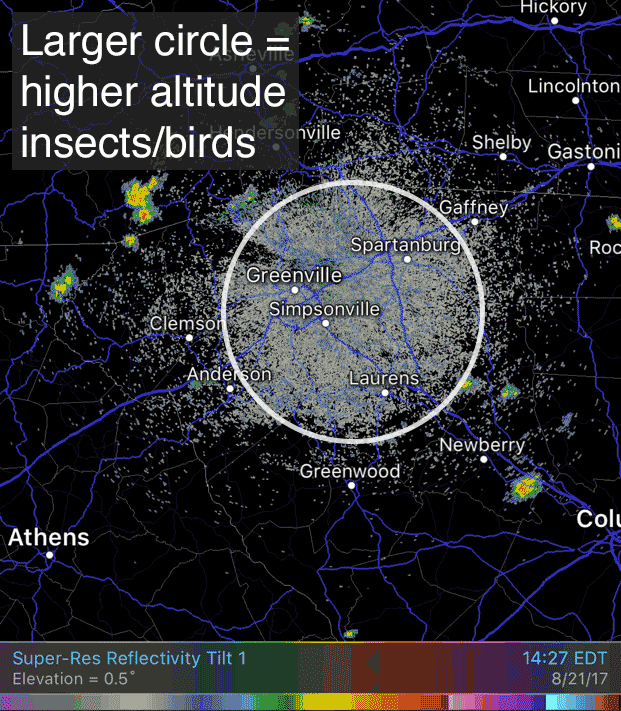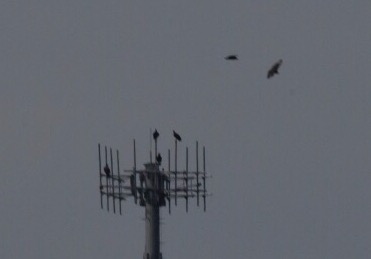With the total solar eclipse of 8 April 2024 close at hand, we are highlighting a previous BirdCast new item describing behaviors observed during the 21 August 2017 total solar eclipse. See below to review the original post to get reacquainted with some of the behaviors we expect to see and, so, too, to get excited about observing behaviors on 8 April!
By Benjamin Van Doren, Andrew Farnsworth, and Ian Davies
Approximately every 18 months a total solar eclipse is visible somewhere on the surface of the Earth. During previous total solar eclipses, numerous observers have reported interesting animal behavior—especially describing birds. With the advent of citizen science and projects like eBird, we now have the opportunity to examine bird behaviors as reported by a large number of observers almost immediately and at a much grander scale. The amazing accounts below of birding during Monday’s total solar eclipse are all from eBird checklists submitted by birders like you—please submit your eclipse sightings if you haven’t already!
We looked at 7,800 checklists submitted to eBird.org on August 21, 2017 and focused on 1,350 checklists submitted from the time of maximum eclipse. Below, we highlight interesting observations from the path of totality (black circular icons with white borders, representing a total eclipse) and outside of it (partial eclipse icons of varying magnitude).
Click on each icon and the link to each checklist to read how eBirders experienced and documented the event. We noticed that observers were less likely to note behavioral effects at sites where sun obscuration was less than 95%.
Highlights
Aerial insectivores dropping out of the skies
Several observers noted aerial feeders like swallows and swifts appearing at low altitudes as the midday light waned – potentially having descended to roost. Jeff Shenot submitted the following fascinating observation of 161 Purple Martins:
I looked out to check the solar eclipse, which started here about 30 minutes ago. After a few minutes I noticed a huge flock (for here) of Purple Martins that started dropping out of the sky. Many were so high up I couldn’t identify them at first, just specks. They came down and landed on a utility wire at first, and as they kept coming they began to also land in adjacent trees near the tree tops. It was mostly sunny and calm, and I thought it was very weird that they would suddenly drop down to here out of migration, in the middle of the day. Not to mention that by now most PUMAs [Purple Martins] are far south of here.
They were clearly migrants (not local breeders) and there was no apparent reason for them to suddenly come down here. I have no suggestion for a reason other than maybe they were confused or disoriented by the eclipse?
Also, normally PUMAs [Purple Martins] are very vocal but these were oddly very quiet. I counted them by 1s, and had 161 of them in view at once. Then they all got up at once at 2:49, shortly after the eclipse “peak” (for here). They were flying around, etc and many went soared back up high and took off. but about 50 lingered in the vicinity. Those that stayed were soaring around excitedly and calling a lot for about 10-15 minutes and eventually they all left too. Cool!
From Joshua Stone and Nicole Trimmer in Johnson County, Illinois:
Just before totality, the chimney swifts started flying low and acting like it was dusk. They continued during totality, flying low overhead and chittering.
From Bill Michalski in St. Louis City County, Missouri:
Observed 5-10 Chimney Swifts (and their telltale song) soaring over the park as it grew dark about 5-10 mins. before the eclipse totality at 1:17 PM. In the 5 minutes during and after the totality, their number grew to at least 40 from my vantage point (probably many more). By 1:25 PM they appeared to be all gone.
From John Parker in Jefferson County, Idaho:
In total close to 500 swallows of which nearly all were BANS [Bank Swallows]. During the eclipse they roosted on the sedge and rushes.
Radar reveals an emptying sky
We looked to Doppler radar imagery to see whether we could corroborate these observations at a larger scale. The following radar loop, from South Carolina, shows aerial animals (certainly some insects and birds, although we have not yet tried to characterize what is flying) getting lower to the ground as the eclipse progressed, being lowest in the minutes after totality, and then taking to the air again as the eclipse ended. We’ve highlighted the descent of animals by manually drawing a white circle in each frame to show the extent of aerial fauna—note how the circle shrinks in size as totality approaches and then enlarges afterwards.

We will continue to investigate these patterns, using recent advances in processing and analysis of radar data to study how animals reacted to the solar eclipse.
Nocturnal (and crepuscular) birds emerge
Observations of Common Nighthawks were widespread during totality.
Steven Kahl on 26 nighthawks:
All in one flock that appeared out of nowhere to the west of station. Birds came from the north flying south in a line 1-4 birds deep and wide; less than 1/4 mi south of station, birds swung around and headed back north directly overhead. Reached my location near end of totality and started dispersing. Bird perched in tree next to me during previous count never moved during totality.
Other observers of nighthawks during totality include Ian/William Hearn, Glenn Kincaid, Debra Corpora, Kristie Nelson, Frank Pinilla, Kevin Bennett, and Barbara Taylor.
Owls were out, including Barred Owl in Georgia and Illinois, Great Horned Owl in South Carolina and Eastern Screech-Owl in South Carolina:
Singing emphatically and making odd contact calls for about 2 minutes starting 20 seconds after the end of totality, when ambient light picked up again.
Nocturnal migrants acted as if they were set to depart for a night-long migratory journey.
Three Yellow Warblers and a Wilson’s Warbler popped out of lush green undergrowth into top of dead tree, flitted for a few seconds giving nocturnal flight calls. Acted as though they were about to take off for night migration. Flew off toward a different treed area.
Finally, even as far away as New Jersey, BirdCast’s own Andrew Farnsworth noted an intriguing Baltimore Oriole:
Coolest of all behaviors. I watched this bird from the boardwalk slowly work its way from mid story in a small relatively open ornamental to the top of the tree, and after about 3-5 minutes atop the tree, the bird took flight and flew straight SE over the road and toward the ocean. I ran to the beach to watch the bird, and I saw it fly basically out of sight over the ocean, clearly showing what looked like nocturnal migratory behavior of over water migration! The bird did not climb terribly fast, maintaining an even gain in altitude. I watched the bird circle back, and though it did not return to the same perch from which it originated, it did return to a patch of trees somewhere to my south and then out of sight.
Roosting and confusion
Joe Donahue photographed Black Vultures “coming into roost for the eclipse”:
Larry Versaw from Scotts Bluff County, Nebraska:
Turkey Vultures “flew off from the ground or a tree when light returned at end of total eclipse,” and 12 Black-billed Magpies “flocked into a tree as if to roost as sky darkened rapidly; immediately dispersed as sky lightened.”
And an observation of a confused Mourning Dove by Laura Mae in Greenville County, South Carolina:
It flew to us in a haste and almost crash landed in tree above our heads. We speculated that it was anxious to get to an overnight roosting location before darkness. It was a moment or two before the total solar eclipse’s totality. Darkness was descending rapidly, crickets started to chirp, flowers began closing, the bottom of the sky went pink and we observed eclipse/double shadows. This location had 2 mins 14 seconds of totality followed by shadow bands wiggling on the pavement in front of us. It was incredible!
Courtney Buxton, Hugh Buxton, Jim Buxton, and Julian Buxton also documented confusion in South Carolina:
Total eclipse at 2:47pm that lasted for almost 2 minutes. Moon covering sun appeared lavender with pink solar providences that may have appeared this way due to light cloud cover. Absolutely zero bird activity immediately before and for about 45 seconds into the totality. Then herons were flying back by the dozens to roost, diving into the pond next to our location. Record number of Wood Storks (22) rose from the marshes about 300 yds east of our location, utterly confused. 13 split off and flew north in formation, 9 stayed relatively stationary, rose up in the air, circling higher and seemed also confused. The latter 9 then eventually headed back toward the marsh as the sun began to emerge. Three kites were flying in weaving patterns above the treetops–also heading back to known roost site. It was brief, but there was definite bird confusion. For the first few minutes afterward, Chimney Swifts and swallows were everywhere, but clearly after the herons.
Shanna Kahler on a confused Cooper’s Hawk:
During totality of the eclipse – The bird was acting confused, flying erratically about 10 feet overhead, alternating rapid wing flaps and short glides and quick direction changes as it flew around the hotel parking lot. There were no other birds present.
Other species noted to roost include Northern Cardinal, Red-tailed Hawk, and Eurasian Collared-Dove.
Andrew Farnsworth also noted interesting and conflicting behaviors among coastal birds:
Larger than usual day time numbers [of gulls], also moving in small groups north and south along the beach in the direction of typical roosts. Very different diurnal behavior than typical day time activities, such as loafing on the beach.
See Andrew’s checklist for more.
We are not the only people to ponder animal behavior during solar eclipses. Check out this project and this array of papers!





